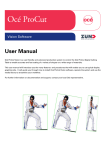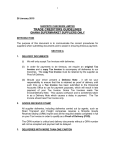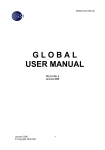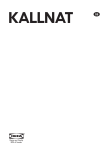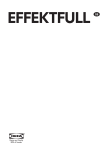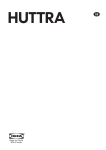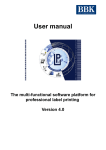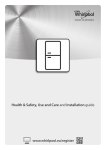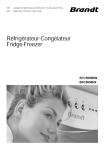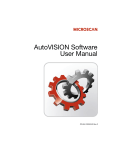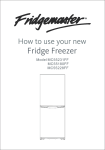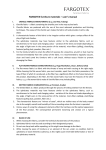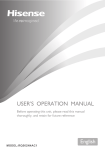Download Shoprite Group Bar Coding Standards _Rel 2 01e1
Transcript
Bar Coding Standards for Items Supplied to the Shoprite Checkers Group Introduction Shoprite Checkers was one of the pioneers in the use of bar coding in the South African retail industry. As this method of item identification and tracking has become more and more pervasive over time, the reliance on it for improving not only logistics but also our customers’ overall shopping experience has escalated. Whilst international standards have been published by the controlling body, GS1, for the use of members of those bodies, they have not been adequately enforced until now. This has resulted in escalating costs to the Shoprite Checkers Group, degradation in the quality of our customers’ shopping experience, and a stumbling block in the path of increased usage of bar codes in automation of the logistics systems throughout the supply chain. With the publication of the Shoprite Checkers requirements within our community of business partners, we expect the unreserved adoption of, and adherence to, those standards by our trading partners for the mutual benefit of all parties. There will be no exceptions or any relaxation of standards unless agreed to in writing by Shoprite Checkers Bar Code Quality management. Scope The Shoprite Checkers Bar Coding Standards address the following areas: • • Use of appropriate symbology for a particular application o Symbols for retail units o Symbols for shrink-wrapped retail units in the form of a multi-pack that can be a retail unit or a traded item contained within a larger distribution unit o Symbols for traded items at various levels of containment o Symbols for single-unit cases where the traded item is also a retail unit o Use of containment levels in barcodes Methods of applying the symbol to the packaging o Positioning and orientation of the symbol on the packaging o Location o Prevention of show-through o Printing methods and standards § Means of marking units § Magnification factors § Quality standards and verification Applicability and Amendment This document must be read in conjunction with the international standards documents published and amended from time to time by GS1 and which are available via GS1 or the local controlling body of each member country. In all cases, the latest version available from GS1 will be assumed to be the final arbiter of acceptable bar code symbol quality and application standards, and any changes published by GS1 will be assumed to be in force within the Shoprite Checkers Group, superseding the standards contained herein. Our trading partners must therefore remain abreast of changes in these internationally agreed standards and take steps to comply with them in as short a time as is reasonable. © Shoprite Group of Companies 2008 v2.00e1 (updated to GS1 GenSpec V8) Page 1 of 13 A. Consumer Units All items for retail sale other than unpackaged fresh produce or items sold in random quantities determined by the customer will be marked with the appropriate symbol selected from the following list: EAN-13 Items where the packaging allows for a full-sized bar code symbol and the product is produced or packaged in or for a member country of EAN, or where the Global Trade Identification Number (GTIN) is provided by the Shoprite Checkers Group for a private label item EAN-8 Items too small for an EAN-13 symbol, subject to the geographical provisos above Until 01 January 2005 UPC-A Items where the packaging allows for a full-sized bar code symbol and the product is produced or packaged in or for a member country of UCC UPC-E Items too small for a UPC-A symbol subject to the geographical provisos above From 1 January 2005 EAN-13 and EAN-8 can be used for exports to the USA and Canada. From 1 January 2010, GS1-DataBar symbols will be accepted within the Shoprite Group. Random-weight products that are pre-packed for sale by South African suppliers in Shoprite Checkers Group stores and price-marked with a price-embedded bar code symbol will use an EAN-13 symbol with a 28 or 29 prefix controlled by GS1. From 1 January 2010, GS1 DataBar symbols will be accepted and these should also include the Sell By or Best By date prefaced by the correct Application Identifier. All EAN symbols will include human-readable characters below them and should have light margin indicators in order to preserve the Quiet Zones. Positioning and orientation The symbol, including the human readable digits underneath (identification number), must be completely visible and free of any obstructions that may prevent it from scanning. If the item is random-wrapped or flow-wrapped, the same symbol can be printed more than once on the wrapping. This ensures that one complete symbol is always visible. The symbol must be positioned no closer than 8mm from seams or creases in the packaging that may cause distortion of the symbol and affect the scan rate: this is particularly important in the case of flow-wrapping where bar code symbols may be obscured by folds and seams after sealing the wrapper. The preferred location for a symbol is in the lower right quadrant of the panel opposite the promotional panel, respecting the proper Quiet Zone areas around the symbol and the edge rule. The alternative is in the lower right quadrant of another side of the container. Edge rule: The symbol must not be closer than 8 mm or further than 100 mm from the nearest edge of the package/container. The preferred orientation for the symbol is “picket fence” with the bars perpendicular to the bottom edge of the product. . If the product is cylindrical with a diameter of less than 50mm in the case of a UPC-A or EAN-13 symbol, or 35mm in the case of a UPC-E or EAN-8 symbol, the symbol must be positioned “ladder-style” with the bars parallel to the natural bottom edge of the product. In all cases, no symbol may be printed on a curved surface in “picket fence” orientation if the angle included between the radii from the outer edge of the quiet zone at each side to the centre of the radius of curvature of that face is less than 60°. © Shoprite Group of Companies 2008 v2.00e1 (updated to GS1 GenSpec V8) Page 2 of 13 As a general rule, if the radius of the cylinder is less than the width of the symbol (including Quiet Zones) then the symbol must be rotated 90° and printed in “ladder” orientation. No symbol on a retail unit may be printed at less than 80% of nominal size unless printed using a thermal printer, in which case the lowest magnification is 75%. The maximum magnification permissible is 200%. (See Appendix 2). A minimum magnification of 90% is recommended for general use and increased here the print process or substrate make this desirable for better scanning. The bar height should never be truncated and should correspond with its magnification. (See Appendix 2). Where truncation is unavoidable owing to the physical size of the product, it must be kept to less than 10% reduction of the correct height. Thermal Labels Where an item is marked by means of a label created on demand and printed by means of a thermal printer, there should be an unbroken check bar across the top of the symbol to provide a visual confirmation that the symbol has been printed without errors caused by a malfunctioning print head. An example of this is shown below (not to scale): Thermal labels should be printed with the bars parallel to the direction of print in order to create as straight an edge as possible and to minimise print gain. Small Items There may be difficulty in fully complying with height, magnification and edge rule standards for small items. In these cases, consideration should be given to shelf presentation alternatives as well as the use of EAN-8 symbols in order to get as close as possible to the minimum specifications. © Shoprite Group of Companies 2008 v2.00e1 (updated to GS1 GenSpec V8) Page 3 of 13 B. Shrink-wraps and Multi-packs Symbology Where multiples of an item are contained in a pack, the pack will be marked with an EAN-13 or UPC-A symbol dependent on where the item is to be sold. The GTIN for the multi-pack will be different to that of the contained single units. Each different configuration of multi-pack will have its own unique EAN/UCC-13 or UPC-12 number. All symbols will include human-readable characters below them and should have light margin indicators in order to preserve the Quiet Zones. Positioning and orientation Edge rule: The symbol must not be closer than 8 mm or further than 100 mm from the nearest edge of the package/container. Where the symbol is directly printed onto a heat-shrunk film, it must be positioned such that the shrinking process does not distort it any way or result in seams, flaps or overlaps obscuring the symbol. Never place a bar code symbol on the base of the product. Where the symbol is printed onto a separately applied label, the label must be positioned in accordance with the edge rules and must not be wrinkled, torn or distorted in any manner likely to result in a reduced scan rate. Magnification No symbol on a retail unit may be printed at less than 80% of nominal size unless printed using a thermal printer, in which case the lowest magnification is 75%. The maximum magnification permissible is 200%. (See Appendix 2). A minimum magnification of 90% is recommended for general use and increased here the print process or substrate make this desirable for better scanning. The bar height should never be truncated and should correspond with its magnification. (See Appendix 2). Where truncation is unavoidable owing to the physical size of the product, it must be kept to less than 10% reduction of the correct height. Show Through Under no circumstances must the bar code symbols printed on the single items contained within the shrink-wrap or multi-pack be able to be scanned. To this end, the contained items should either be packed with their individual symbols facing inwards, or the over-wrap must be opaque or printed with an obscuring pattern, or the lip of the tray (if used) must be sufficiently high to fully obscure the symbols. Thermal Labels Where an item is marked by means of a label created on demand and printed by means of a thermal printer, there should be an unbroken check bar across the top of the symbol to provide a visual confirmation that the symbol has been printed without errors caused by a malfunctioning print head. An example of this is shown below (not to scale): Thermal labels should be printed with the bars parallel to the direction of print in order to create as straight an edge as possible and to minimise print gain. © Shoprite Group of Companies 2008 v2.00e1 (updated to GS1 GenSpec V8) Page 4 of 13 C. Outer Cases and Trays Symbology The preferred symbol for use on a logistical unit at this level is Interleaved Two of Five (ITF) -14 or GS1-128; this last alternative should only be used where additional information is to be encoded such as shelf life data or batch number. GS1 standards also permit the use of EAN-13 codes on outer cases. These should not be printed directly on to the outer case or tray, but should rather be printed on labels using a magnification level at the higher end of the range, The use of EAN-13 symbols is strongly discouraged at this level unless used on cases of wine where retail sale is the norm. Where an ITF symbol is used, it must use a 14-digit code comprising of the following: • A level indicator from 1 to 8. Each packing configuration must have a unique level indicator. The indicator should never be linked to a quantity within the outer case but should rather be allocated sequentially as required. • The first 12 digits of the contained item’s GTIN (Bar Code number). If the single item has been shrink-wrapped and these have been marked with a unique bar code, then the outer case will reflect the shrink-wrap’s GTIN. • A check digit calculated using the standard EAN modulo10 method ______________________________________________________________ IXXXXXXXXXXXXC Where I = Indicator with range of 1 to 8. X = EAN number of consumer unit packed in BASE level, excluding its check digit. C = Recalculated check digit. __________________________________________________________________________ ITF-14 symbols printed directly on to the corrugate must have bearer bars on all four sides while symbols printed on to a label require top and bottom bearer bars. The H-gauge may be used to give a visual indication of print quality, but verification should be a normal part of the print quality management process and is preferable. If H-gauges have been used, they must not interfere with the quiet zones. Where a GS1-128 code has been used, it must begin with the application identifier (01) and be followed by a 14 digit GTIN. Additional attribute information is also required eg weight, batch/lot number. UNDER NO CIRCUMSTANCES IS IT ACCEPTABLE TO AFFIX A LABEL OR WRAPPER FROM THE CONTAINED RETAIL UNIT TO AN OUTER CASE OR TO USE ITS NUMBER IN ANY OTHER WAY FOR IDENTIFICATION PURPOSES Positioning and orientation Two symbols need to be visible on outer cases; one on a short side and the other on the adjacent side to the right (in warehouse applications this enables consistent turning to ensure a label is visible). On cases less than 1 metre in height: The symbol should be no lower than 32mm from the bottom edge of the pack and no closer than 19mm to the nearest edge. If a shrink-wrap or multi-pack is a traded item that is only going to be used in the distribution arena, there should be two bar code symbols on the pack; one on the front in the lower right corner and the other on the adjacent short side. “Picket fence” orientation is preferred in all instances. © Shoprite Group of Companies 2008 v2.00e1 (updated to GS1 GenSpec V8) Page 5 of 13 Where the symbol is directly printed onto a heat-shrunk film, it must be positioned such that the shrinking process does not distort it any way or result in seams, flaps or overlaps obscuring the symbol. This practice is discouraged owing to the distortion resulting from the shrinking process. Where the symbol is printed onto a separately applied label, the label must be positioned in accordance with the edge rules and must not be wrinkled, torn or distorted in any manner likely to result in a reduced scan rate. For units greater than 1 metre in height (excluding pallets), labels should be placed so that all the symbols are at a height of between 400 mm and 800 mm from the base of the unit, and no closer than 50 mm to the vertical edge. Where an item is shrink-wrapped it must be ensured that the film does not cover the bar code symbol in order to avoid specular reflectance. Where it is not possible to avoid covering the symbol, care must be taken to ensure that seams in the wrapper are not positioned over the symbols. Magnification EAN-13 symbols on cases must be between 150% to 200% of nominal and should only be used if printed on labels or high quality corrugate. Where an ITF-14 symbol is printed on a label and applied to the outer case, the magnification need only be in the range 50% to100% of nominal. For printing directly onto corrugate or other poor substrates, ITF-14 symbols must be at a 100% magnification. GS1-128 symbols should be printed at a minimum height of 32mm. Show Through Under no circumstances must the bar code symbols printed on the single items contained within the shrink-wrap or multi-pack be able to be scanned. To this end, the contained items should either be packed with their individual symbols facing inwards, or the over-wrap must be opaque or printed with an obscuring pattern, or the lip of the tray (if used) must be sufficiently high to fully obscure the symbols. Thermal Labels Where a case or tray is marked by means of a label created on demand and printed by means of a thermal printer with the bars parallel to direction of print, there should be an unbroken check bar across the top of the symbol to provide a visual confirmation that the symbol has been printed without errors caused by a malfunctioning print head. This may be achieved by printing bearer bars. An example of this is shown below (not to scale): © Shoprite Group of Companies 2008 v2.00e1 (updated to GS1 GenSpec V8) Page 6 of 13 Thermal labels should be printed with the bars parallel to the direction of print in order to create as straight an edge as possible and to minimise print gain. D. “Pack Size One” Items This refers to items that are both logistical units as well as retail consumer units. Symbology • Since the item is going to go through point-of-sale, an EAN-13 or UPC-A symbol is necessary. • The EAN-13 symbol should be at a magnification of between 150% and 200% Whilst an EAN-13 only on the outer case would be sufficient to comply with current standards, an ITF-14 symbol is preferred for use on any units being handled within the supply chain at a nonretail level. Where the case is made of corrugated board the ITF-14 symbol may be printed directly on to the outer case, but an EAN or UPC symbol must be printed on a label and affixed to the case. Positioning and orientation Where two symbols are provided, they should be affixed to opposite sides so that only one type of symbol will be visible at any one time when the item is stacked or presented for scanning. If only the EAN-13 is used, positioning rules are as for ITF-14. The rules pertaining to bottom and edge spacing in section A, above, are to be applied. Magnification The magnification of the EAN-13 symbol may be no less than 150% and no more than 200%. An ITF symbol may be no less than 50% unless printed directly on a poor substrate, in which case it must be no less than 100%: it is strongly recommended that ITF symbols are always printed at 100%. Thermal Labels Where an item is marked by means of a label created on demand and printed by means of a thermal printer with the bars parallel to direction of print, there should be an unbroken check bar across the top of the symbol to provide a visual confirmation that the symbol has been printed without errors caused by a malfunctioning print head. This may be achieved by printing bearer bars above and below the symbol as shown below. © Shoprite Group of Companies 2008 v2.00e1 (updated to GS1 GenSpec V8) Page 7 of 13 Thermal labels should be printed with the symbol’s bars parallel to the direction of print in order to create as straight an edge as possible and to minimise print gain. E. “Pallet Labels Symbology: Only a GS1-128 symbol is acceptable for pallet labels. For a homogeneous pallet, the minimum information required is the GTIN of the traded item. The use of a Serial Shipping Container Code is also recommended for ease of identification and inclusion with any delivery documentation. Where a pallet contains more than one traded item then a Serial Shipping Container Code must be included in the symbol. In these cases it is not possible to use a GTIN Full recommendations for the label layout may be found in the GS1 Global User Manual. Positioning and orientation h < 800 mm (32”) h> 400 mm (16”) x x > 50 mm (2”) x For pallets, labels should be placed so that all the bar code symbols are at a height of between 400 mm and 800 mm from the base of the unit, and no closer than 50 mm from the vertical edge. Magnification Based on their nominal dimensions (X-dimension: 1 mm), the GS1-128 Symbols can be printed with a magnification factor ranging from 25% to 100%. To ensure efficient reading in any environment, including conveyorised scanning, a minimum magnification factor of 50% should be used. © Shoprite Group of Companies 2008 v2.00e1 (updated to GS1 GenSpec V8) Page 8 of 13 Thermal Labels Where a pallet is marked by means of a label created on demand and printed by means of a thermal printer with the bars parallel to direction of print, there should be an unbroken check bar across the top of the symbol to provide a visual confirmation that the symbol has been printed without errors caused by a malfunctioning print head. An example of this is shown below (not to scale): Thermal labels should be printed with the bars parallel to the direction of print in order to create as straight an edge as possible and to minimise print gain. General Considerations: Specular Reflectance In order to avoid scanning problems related to unwanted reflections, the bar code symbol should not be printed directly onto a very glossy or metallic surface, or be covered by a transparent film such as shrink-wrap, adhesive tape or a clear high-density plastic cover. Contrast Adequate contrast must be ensured between the symbol’s dark and light bars. This means that a symbol should never be printed directly onto a clear or semi-opaque substrate unless it has a panel of white or other suitable colour printed as a background. Care must be taken to ensure correct use of colours in order to guarantee acceptable contrast. Special Considerations for Inkjet Printers Inkjet printers are more likely to produce a poor quality bar code symbol in a high-speed production environment. Every symbol should be checked for readability by scanning heads positioned immediately after the printing stage with the data read being compared to the data printed. Any errors detected must result in the offending packaging being removed from the line and discarded. This is not a substitute for verification. F. Verification and Acceptable Quality All packaging entering the Shoprite Checkers Group supply chain, from pallet (if applicable) to the consumer unit must have undergone random sampling throughout the life of the product to ensure that quality is maintained at the specified standard. All new items, promotional packages and newly packaged products, for Retail and Non-Retail Trade units submitted to the Group for listing must be accompanied by a recent verification and scanability report that meets the criteria given below. Shoprite reserves the right to request new reports if it deems the supplied reports to be excessively old or not representative of the samples provided. In the event of problems being experienced in scanning packaging at any point in the supply chain, the provider of that packaging will be asked to provide a verification and scanability report after having the problem remedied. © Shoprite Group of Companies 2008 v2.00e1 (updated to GS1 GenSpec V8) Page 9 of 13 Where the Group claims that packaging is below the agreed standard, this will be supported by samples of the offending packaging and a verification report detailing the points of failure. Responsibility for bringing the packaging up to the required standard rests with the supplier or agent with whom the Contract for the product has been entered into. Verification employs the testing methods of ISO/IEC 15416 and the print qualities of GS1 General Specifications to deliver a test of the printed barcode before it is released into the market place. Modern verification methods give suppliers practical information about how to improve bar codes to ensure they meet the standard. Scanability checks such things as the positioning of the bar code on the product, orientation and show-through as well as its first time scan rate. Products for testing can be sent to GS1 South Africa (011) 789 5777. Type of verifier Only reports produced from verifiers meeting the requirements of ISO/IEC 15426-1 will be accepted. Acceptable grades For all bar code symbols other than ITF-14 printed on corrugated board, the grade achieved on verification must be ISO/CEN 1.5 (ANSI grade C) or better on the finished item as presented on shelf. ITF-14 symbols on corrugated card will be accepted at ISO/CEN 0.5 (ANSI grade D) or better. The aperture of the verifier used must be appropriate to the type of symbol being verified and its level of magnification. An example of an acceptable verification report is attached as Appendix 1 Parameters to be recorded The following criteria must be reflected in the verification report: • Aperture • Wavelength • Reader type • Number of scans • Code type, count of bars and spaces, NBW • Average grade • Average bar gain tolerance • Magnification • Symbol contrast • Minimum reflectance • Minimum edge contrast • Modulation • Defects • Decode • Decodability The final grade given to a bar code symbol is the lowest score of any of the rated parameters. Bar Growth It must be remembered that a verifier measures print quality against ISO/IEC15416 and grades accordingly. However, the applicable definition of the type of symbol being used must also be considered and the parameters in that definition applied. Where the bar gain or loss as measured © Shoprite Group of Companies 2008 v2.00e1 (updated to GS1 GenSpec V8) Page 10 of 13 by an ISO grade verifier exceeds the permitted tolerances within the relevant ISO/IEC standard then the symbol will still be deemed to be a failure as it is out of the appropriate specification. Scanability This is to be tested under conditions relevant to the product. A minimum of 10 scans must be done to determine a first time scan percentage. Packaging samples should be filled with the product and the bar code should be on the package as it would appear after manufacture. Testing should be carried out using a vertical or “slot” scanner similar to those employed in Shoprite Group stores and not a hand-held model. Ongoing quality management Shoprite Checkers reserves the right to carry out its own verification of packaging at all levels of containment of a traded item from time to time and at any stage of the life of a product. Where such verification indicates that the packaging does not meet the minimum criteria then Shoprite Checkers may insist on actions to be taken within a mutually agreed time span to rectify the situation. In the event of failure to rectify the sub-standard packaging then Shoprite Checkers reserves the right to take whatever steps it deems necessary to minimise costs incurred as a result of sub-standard packaging entering its supply chain. G. Re-Use of Barcodes and Need for New Bar Codes The GS1 guidelines for issuing new bar codes or re-using previously issued bar codes are to be followed in all instances. © Shoprite Group of Companies 2008 v2.00e1 (updated to GS1 GenSpec V8) Page 11 of 13 Appendix 1 © Shoprite Group of Companies 2008 v2.00e1 (updated to GS1 GenSpec V8) Page 12 of 13 Appendix 2 Dimensions of EAN/UPC symbols including quiet zones at different magnification factors. Magnification factor Module width (ideal) [mm] 0.75 EAN-13/UPC-A dimensions [mm] Width Height 27.97 19.43 EAN-8 dimensions [mm] Width Height 0.80 0.264 29.83 20.73 21.38 17.05 0.85 0.281 31.70 22.02 22.72 18.11 0.90 0.297 33.56 23.32 24.06 19.18 0.95 0.313 35.43 24.61 25.39 20.24 1.00 0.330 37.29 25.91 26.73 21.31 1.05 0.346 39.15 27.21 28.07 22.38 1.10 0.363 41.02 28.50 29.40 23.44 1.15 0.379 42.88 29.80 30.74 24.51 1.20 0.396 44.75 31.09 32.08 25.57 1.25 0.412 46.61 32.39 33.41 26.64 1.30 0.429 48.48 33.68 34.75 27.70 1.35 0.445 50.34 34.98 36.09 28.77 1.40 0.462 52.21 36.27 37.42 29.83 1.45 0.478 54.07 37.57 38.76 30.90 1.50 0.495 55.94 38.87 40.10 31.97 1.55 0.511 57.80 40.16 41.43 33.03 1.60 0.528 59.66 41.46 42.77 34.10 1.65 0.544 61.53 42.75 44.10 35.16 1.70 0.561 63.39 44.05 45.44 36.23 1.75 0.577 65.26 45.34 46.78 37.29 1.80 0.594 67.12 46.64 48.11 38.36 1.85 0.610 68.99 47.93 49.45 39.42 1.90 0.627 70.85 49.23 50.79 40.49 1.95 0.643 72.72 50.52 52.12 41.55 2.00 0.660 74.58 51.82 53.46 42.62 © Shoprite Group of Companies 2008 (updated to GS1 GenSpec V8) Page 13 of 13 v2.00e1













